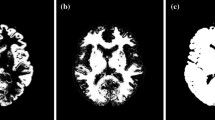Abstract
In follow-up brain magnetic resonance imaging (MRI), precise reproducibility of the scan prescription is important so that over- or underestimating changes in volumes of clinical interest is prevented. (The scan prescription is defined as the location and orientation of the head with respect to the scan planes of the three-dimensional MRI matrix.) In this study, the misregistration between the original and a second scan was calculated in the case of both manual positioning and automatic positioning. These calculations were carried out both for a healthy volunteer scanned repeatedly and, in a retrospective study, for 225 patients who had an original and at least one follow-up scan. The effects of the scan operator being the same for both scans or being different were also examined. A commercially available 1.5 Tesla MRI system and a six-element head-array coil were employed in all of the imaging. The reproducibility of the scan prescription was determined by the registration of the original scan image to the follow-up scan image by use of the Fourier phase correlation method. Our results showed that (1) the reproducibility by automatic positioning was superior to that by manual positioning (p < 0.05), and (2) there was no significant difference in the results between when the operator was the same or different (p > 0.05). We conclude that, in follow-up brain MRI, automatic positioning should be used, because manual positioning decreases the reproducibility of the scan prescription even if the same operator performs the second scan.








Similar content being viewed by others
References
Vaidyanathan M, Clarke LP, Hall LO, Heidtman C, Velthuizen R, Gosche K, Phuphanich S, Wagner H, Greenberg H, Silbiger ML. Monitoring brain tumor response to therapy using MRI segmentation. Magn Reson Imaging. 1997;15:323–34.
Simon JH, Scherzinger A, Raff U, Li X. Computerized method of lesion volume quantitation in multiple sclerosis: error of serial studies. AJNR Am J Neuroradiol. 1997;18:580–2.
Rovaris M, Gawne-Cain ML, Sormani MP, Miller DH, Filippi M. The effect of repositioning on brain MRI lesion load assessment in multiple sclerosis: reliability of subjective quality criteria. J Neurol. 1998;245:273–5.
Clarke LP, Velthuizen RP, Clark M, Gaviria J, Hall L, Goldgof D, Murtagh R, Phuphanich S, Brem S. MRI measurement of brain tumor response: comparison of visual metric and automatic segmentation. Magn Reson Imaging. 1998;16:271–9.
Guttmann CR, Kikinis R, Anderson MC, Jakab M, Warfield SK, Killiany RJ, Weiner HL, Jolesz FA. Quantitative follow-up of patients with multiple sclerosis using MRI: reproducibility. J Magn Reson Imaging. 1999;9:509–18.
Kikinis R, Guttmann CR, Metcalf D, Wells WM 3rd, Ettinger GJ, Weiner HL, Jolesz FA. Quantitative follow-up of patients with multiple sclerosis using MRI: technical aspects. J Magn Reson Imaging. 1999;9:519–30.
Tan IL, van Schijndel RA, van Walderveen MA, Quist M, Bos R, Pouwels PJ, Desmedt P, Adèr HJ, Barkhof F. Magnetic resonance image registration in multiple sclerosis: comparison with repositioning error and observer-based variability. J Magn Reson Imaging. 2002;15:505–10.
Itti L, Chang L, Ernst T. Automatic scan prescription for brain MRI. Magn Reson Med. 2001;45:486–94.
Welch EB, Manduca A, Grimm RC, Jack CR Jr. Interscan registration using navigator echoes. Magn Reson Med. 2004;52:1448–52.
Gedat E, Braun J, Sack I, Bernarding J. Prospective registration of human head magnetic resonance images for reproducible slice positioning using localizer images. J Magn Reson Imaging. 2004;20:581–7.
van der Kouwe AJ, Benner T, Fischl B, Schmitt F, Salat DH, Harder M, Sorensen AG, Dale AM. On-line automatic slice positioning for brain MR imaging. Neuroimage. 2005;27:222–30.
Benner T, Wisco JJ, van der Kouwe AJ, Fischl B, Vangel MG, Hochberg FH, Sorensen AG. Comparison of manual and automatic section positioning of brain MR images. Radiology. 2006;239:246–54.
Nelles M, Gieseke J, Urbach H, Semrau R, Bystrov D, Schild HH, Willinek WA. Pre- and postoperative MR brain imaging with automatic planning and scanning software in tumor patients: an intraindividual comparative study at 3 Tesla. J Magn Reson Imaging. 2009;30:672–7.
Reddy BS, Chatterji BN. An FFT-based technique for translation, rotation, and scale-invariant image registration. IEEE Trans Image Process. 1996;5:1266–71.
Foroosh H, Zerubia JB, Berthod M. Extension of phase correlation to subpixel registration. IEEE Trans Image Process. 2002;11:188–200.
Hoge WS. A subspace identification extension to the phase correlation method. IEEE Trans Med Imaging. 2003;22:277–80.
Yosi K, Yoel S, Amir A. Volume registration using the 3-D pseudopolar Fourier transform. IEEE Trans Signal Process. 2006;54:4323–31.
Jakub B, Jan F. 3D rigid registration by cylindrical phase correlation method. Pattern Recognit Lett. 2009;30:914–21.
Nelder JA, Mead R. A simplex method for function minimization. Comput J. 1965;7:308–13.
Press WH, Teukolsky SA, Vetterling WT, Flannery BP, Numerical recipes in C Japanese edition, Gijutsu Hyoron Sha; 1993. p. 295–9.
Acknowledgments
This research was partially supported by a Grant-in-Aid for Scientific Research (KAKENHI No. 21591571).
Conflict of interest
The authors declare that they have no conflict of interest in this article.
Author information
Authors and Affiliations
Corresponding author
About this article
Cite this article
Kojima, S., Hirata, M., Shinohara, H. et al. Reproducibility of scan prescription in follow-up brain MRI: manual versus automatic determination. Radiol Phys Technol 6, 375–384 (2013). https://doi.org/10.1007/s12194-013-0211-8
Received:
Revised:
Accepted:
Published:
Issue Date:
DOI: https://doi.org/10.1007/s12194-013-0211-8




